wipers TOYOTA AVALON 2021 Owners Manual (in English)
[x] Cancel search | Manufacturer: TOYOTA, Model Year: 2021, Model line: AVALON, Model: TOYOTA AVALON 2021Pages: 548, PDF Size: 13.4 MB
Page 3 of 548

3
1
8 7 5 4
3
2
9
6
3-1. Key information
Keys .................................. 122
3-2. Opening, closing and
locking the doors
Doors................................. 125
Trunk ................................. 131
Smart key system.............. 135
3-3. Adjusting the seats
Front seats ........................ 142
Rear seats ......................... 144
Driving position
memory ........................... 146
Head restraints .................. 151
3-4. Adjusting the steering
wheel and mirrors
Steering wheel .................. 153
Inside rear view mirror....... 155
Outside rear view
mirrors ............................. 157
3-5. Opening and closing
the windows
Power windows ................. 160
Moon roof .......................... 1644-1. Before driving
Driving the vehicle ............. 170
Cargo and luggage ............ 178
Vehicle load limits .............. 181
Trailer towing ..................... 182
Dinghy towing .................... 183
4-2. Driving procedures
Engine (ignition) switch...... 184
Automatic transmission ..... 189
Turn signal lever ................ 195
Parking brake .................... 196
Brake Hold ......................... 200
4-3. Operating the lights
and wipers
Headlight switch ................ 202
Automatic High Beam ........ 206
Windshield wipers
and washer ...................... 210
4-4. Refueling
Opening the fuel tank
cap................................... 214
3Operation of each
component4Driving
Page 17 of 548
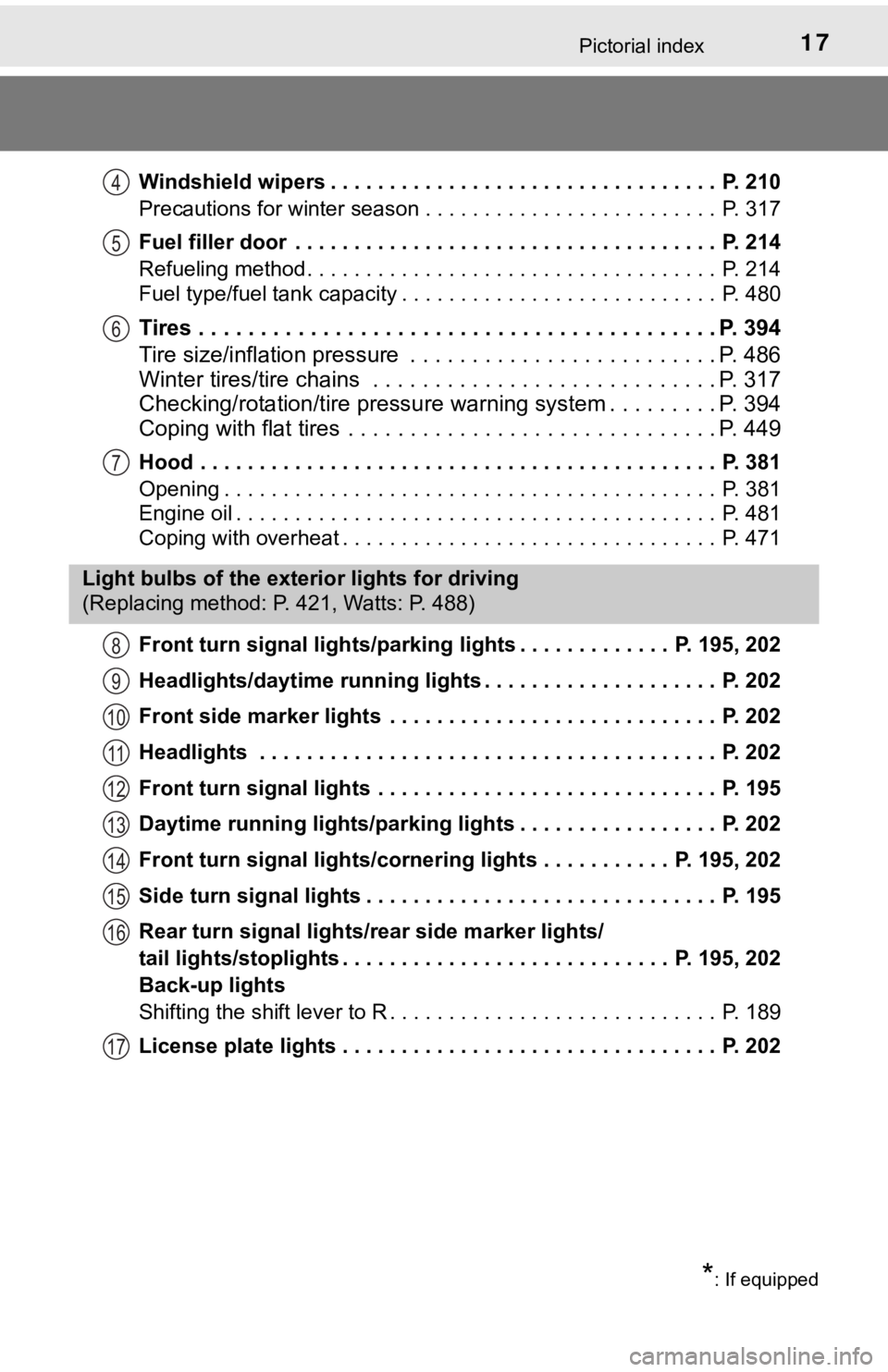
17Pictorial index
Windshield wipers . . . . . . . . . . . . . . . . . . . . . . . . . . . . . . . . . P. 210
Precautions for winter season . . . . . . . . . . . . . . . . . . . . . . . . . P. 317
Fuel filler door . . . . . . . . . . . . . . . . . . . . . . . . . . . . . . . . . . . . P. 214
Refueling method . . . . . . . . . . . . . . . . . . . . . . . . . . . . . . . . . . . P. 214
Fuel type/fuel tank capacity . . . . . . . . . . . . . . . . . . . . . . . . . . . P. 480
Tires . . . . . . . . . . . . . . . . . . . . . . . . . . . . . . . . . . . . . . . . . . P. 394
Tire size/inflation pressure . . . . . . . . . . . . . . . . . . . . . . . . . P. 486
Winter tires/tire chains . . . . . . . . . . . . . . . . . . . . . . . . . . . . P. 317
Checking/rotation/tire pressure warning system . . . . . . . . .P. 394
Coping with flat tires . . . . . . . . . . . . . . . . . . . . . . . . . . . . . . P. 449
Hood . . . . . . . . . . . . . . . . . . . . . . . . . . . . . . . . . . . . . . . . . . . . P. 381
Opening . . . . . . . . . . . . . . . . . . . . . . . . . . . . . . . . . . . . . . . . . . P. 381
Engine oil . . . . . . . . . . . . . . . . . . . . . . . . . . . . . . . . . . . . . . . . . P. 481
Coping with overheat . . . . . . . . . . . . . . . . . . . . . . . . . . . . . . . . P. 471
Front turn signal lights/parking lights . . . . . . . . . . . . . P. 195, 202
Headlights/daytime running lights . . . . . . . . . . . . . . . . . . . . P. 202
Front side marker lights . . . . . . . . . . . . . . . . . . . . . . . . . . . . P. 202
Headlights . . . . . . . . . . . . . . . . . . . . . . . . . . . . . . . . . . . . . . . P. 202
Front turn signal lights . . . . . . . . . . . . . . . . . . . . . . . . . . . . . P. 195
Daytime running lights/parking lights . . . . . . . . . . . . . . . . . P. 202
Front turn signal lights/cornering lights . . . . . . . . . . . P. 195, 202
Side turn signal lights . . . . . . . . . . . . . . . . . . . . . . . . . . . . . . P. 195
Rear turn signal lights/rear side marker lights/
tail lights/stoplights . . . . . . . . . . . . . . . . . . . . . . . . . . . . P. 195, 202
Back-up lights
Shifting the shift lever to R . . . . . . . . . . . . . . . . . . . . . . . . . . . . P. 189
License plate lights . . . . . . . . . . . . . . . . . . . . . . . . . . . . . . . . P. 202
4
5
6
7
Light bulbs of the exterior lights for driving
(Replacing method: P. 421, Watts: P. 488)
*: If equipped
8
9
10
11
12
13
14
15
16
17
Page 169 of 548

169
4Driving
4-1. Before driving
Driving the vehicle ............. 170
Cargo and luggage ........... 178
Vehicle load limits ............. 181
Trailer towing..................... 182
Dinghy towing ................... 183
4-2. Driving procedures
Engine (ignition) switch ..... 184
Automatic transmission ..... 189
Turn signal lever................ 195
Parking brake .................... 196
Brake Hold ........................ 200
4-3. Operating the lights
and wipers
Headlight switch ................ 202
Automatic High Beam ....... 206
Windshield wipers
and washer ..................... 210
4-4. Refueling
Opening the fuel
tank cap .......................... 2144-5. Using the driving
support systems
Toyota Safety Sense P ..... 218
PCS
(Pre-Collision System) .... 226
LDA
(Lane Departure Alert
with steering control) ....... 237
Dynamic radar cruise
controlwith full-speed
range............................... 247
BSM
(Blind Spot Monitor) ........ 260
• BSM function ................ 264
• RCTA function .............. 267
Rear Camera Detection
function (vehicles with
panoramic view
monitor)........................... 272
Intuitive parking assist....... 276
Intelligent Clearance
Sonar (ICS) ..................... 284
Driving mode select
switches .......................... 305
Driving assist systems ...... 309
4-6. Driving tips
Winter driving tips ............. 317
Page 202 of 548
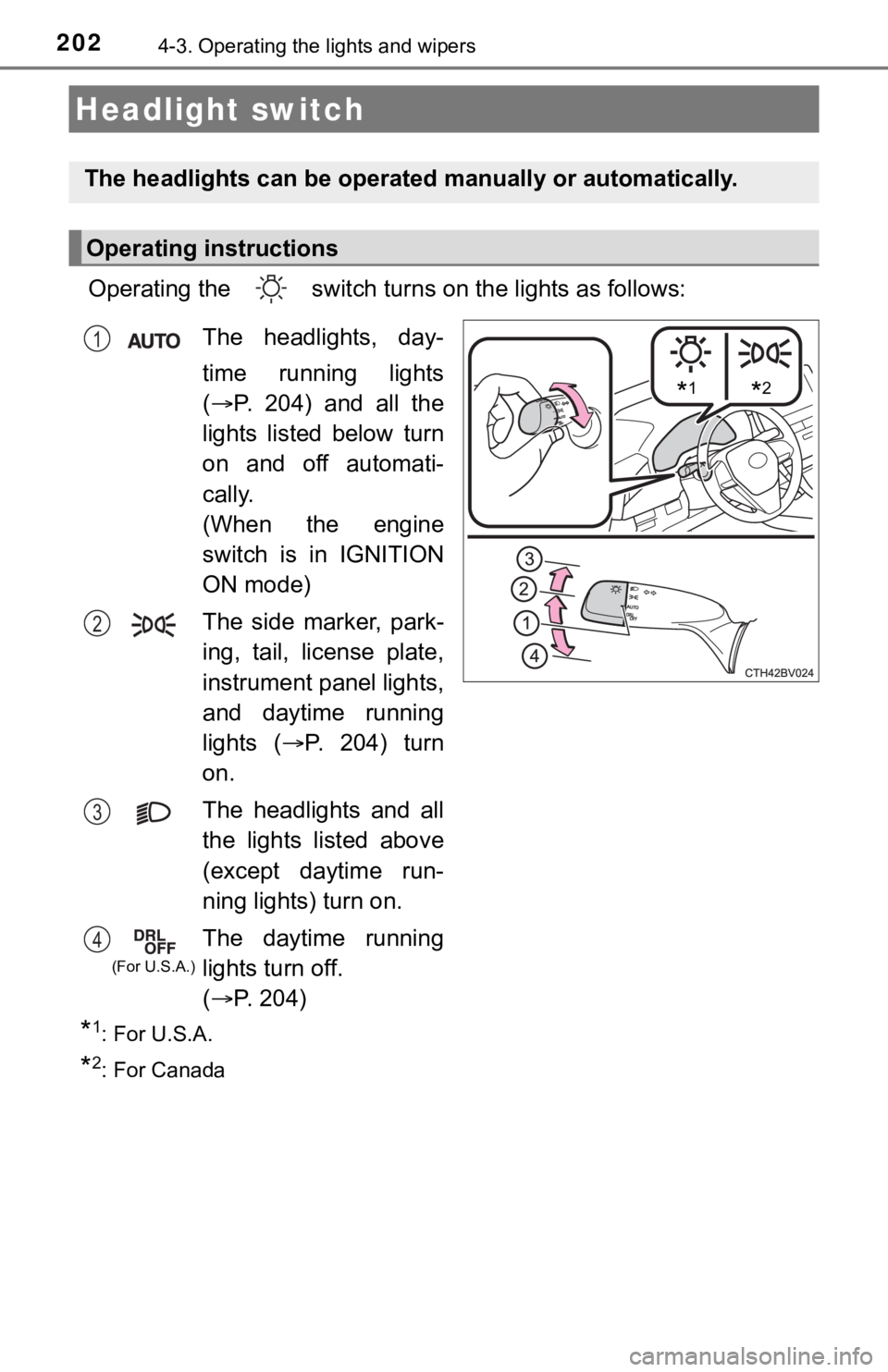
2024-3. Operating the lights and wipers
Operating the switch turns on the lights as follows:
*1: For U.S.A.
*2: For Canada
Headlight switch
The headlights can be operated manually or automatically.
Operating instructions
*1*2
The headlights, day-
time running lights
(P. 204) and all the
lights listed below turn
on and off automati-
cally.
(When the engine
switch is in IGNITION
ON mode)
The side marker, park-
ing, tail, license plate,
instrument panel lights,
and daytime running
lights (P. 204) turn
on.
The headlights and all
the lights listed above
(except daytime run-
ning lights) turn on.
The daytime running
lights turn off.
(P. 2 0 4 )1
2
3
4
(For U.S.A.)
Page 203 of 548
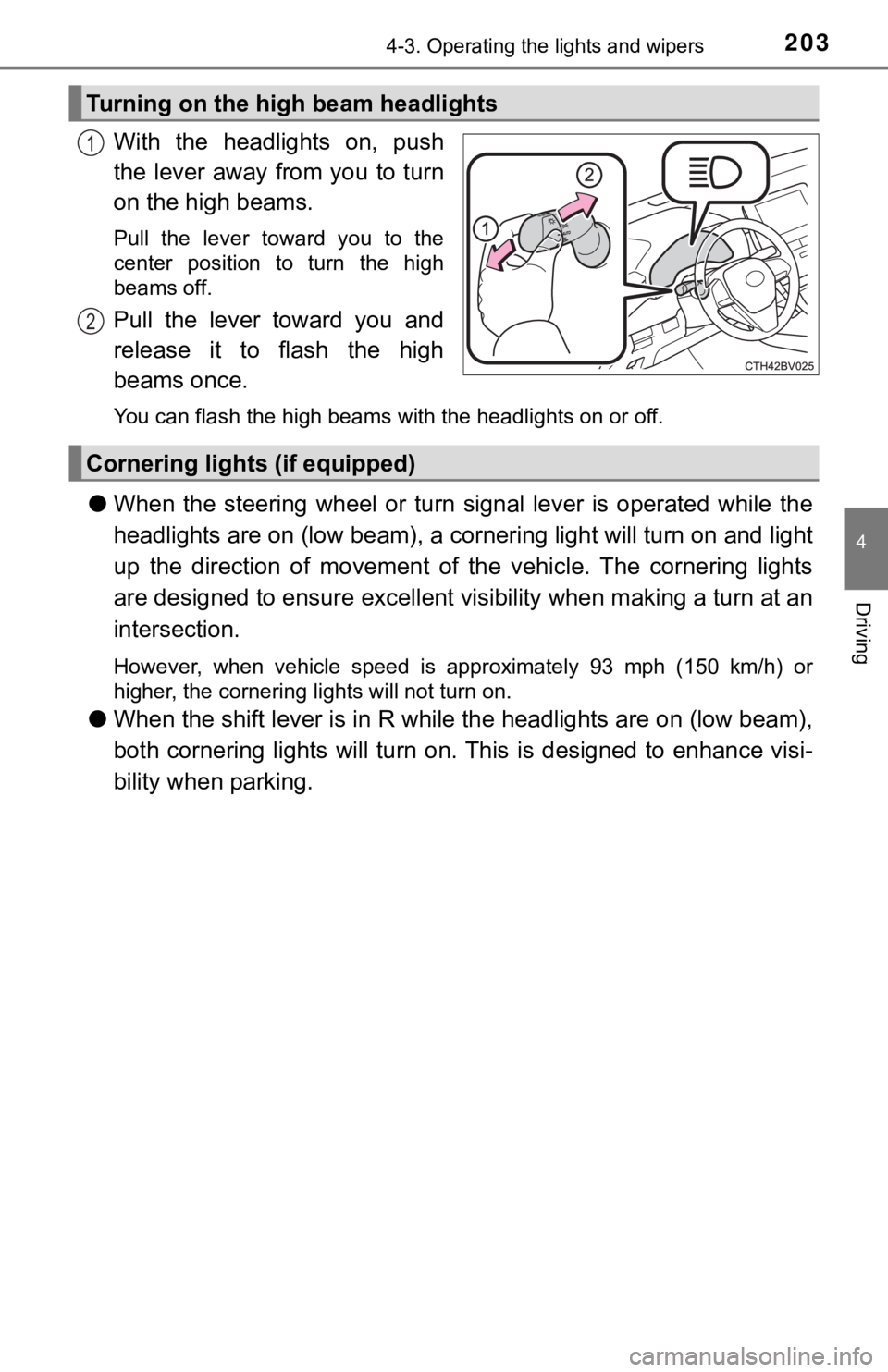
2034-3. Operating the lights and wipers
4
Driving
With the headlights on, push
the lever away from you to turn
on the high beams.
Pull the lever toward you to the
center position to turn the high
beams off.
Pull the lever toward you and
release it to flash the high
beams once.
You can flash the high beams with the headlights on or off.
●When the steering wheel or turn signal lever is operated while the
headlights are on (low beam), a cornering light will turn on and light
up the direction of movement of the vehicle. The cornering lights
are designed to ensure excellent visibility when making a turn at an
intersection.
However, when vehicle speed is approximately 93 mph (150 km/h) or
higher, the cornering lights will not turn on.
●When the shift lever is in R while the headlights are on (low beam),
both cornering lights will turn on. This is designed to enhance visi-
bility when parking.
Turning on the high beam headlights
1
2
Cornering lights (if equipped)
Page 204 of 548
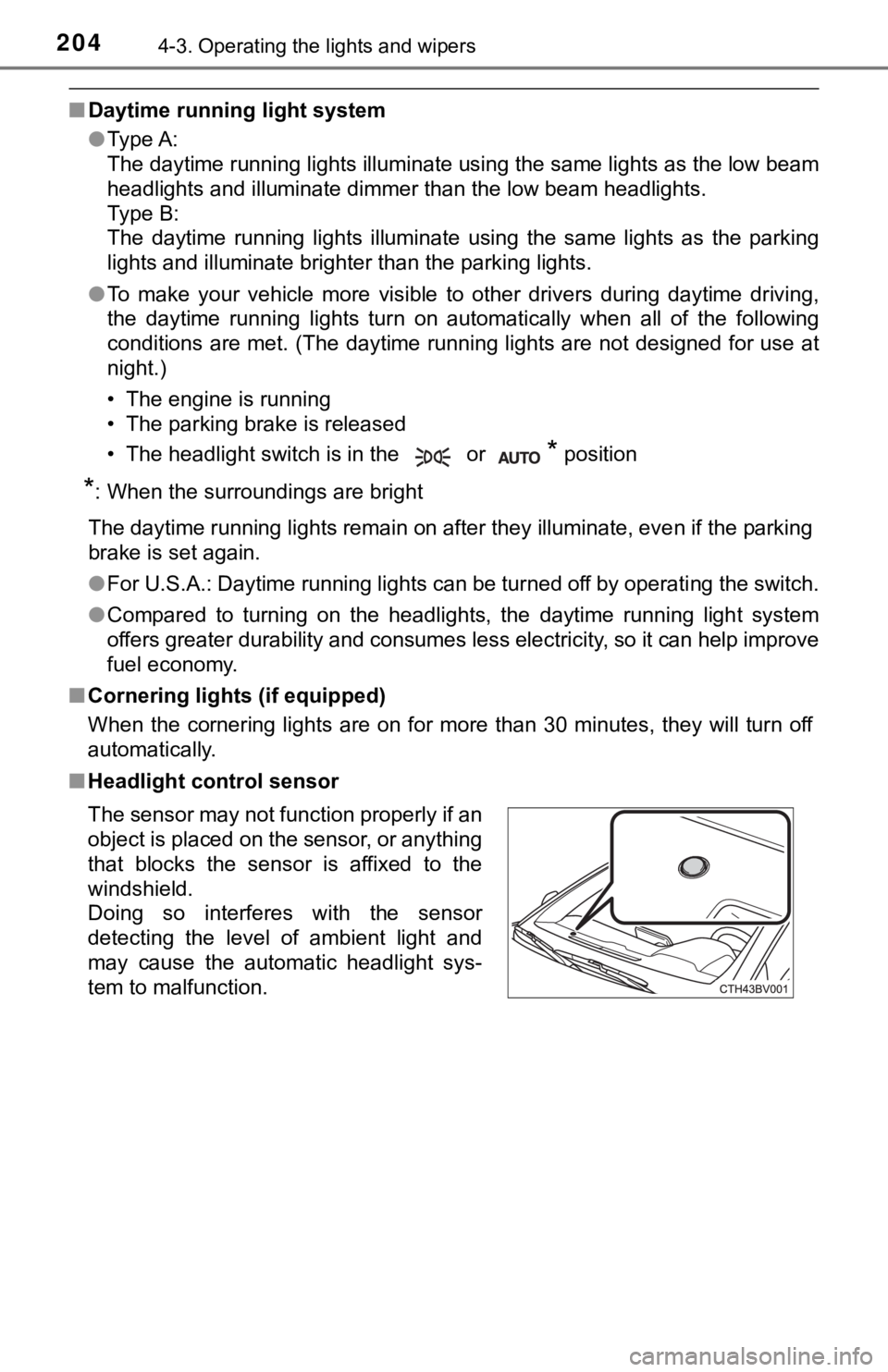
2044-3. Operating the lights and wipers
■Daytime running light system
●Type A:
The daytime running lights illuminate using the same lights as the low beam
headlights and illuminate dimmer than the low beam headlights.
Type B:
The daytime running lights illuminate using the same lights as the parking
lights and illuminate brighter than the parking lights.
●To make your vehicle more visible to other drivers during daytime driving,
the daytime running lights turn on automatically when all of the following
conditions are met. (The daytime running lights are not designed for use at
night.)
• The engine is running
• The parking brake is released
• The headlight switch is in the or
* position
*: When the surroundings are bright
The daytime running lights remain on after they illuminate, even if the parking
brake is set again.
●For U.S.A.: Daytime running lights can be turned off by operating the switch.
●Compared to turning on the headlights, the daytime running light system
offers greater durability and consumes less electricity, so it can help improve
fuel economy.
■Cornering lights (if equipped)
When the cornering lights are on for more than 30 minutes, they will turn off
automatically.
■Headlight control sensor
The sensor may not function properly if an
object is placed on the sensor, or anything
that blocks the sensor is affixed to the
windshield.
Doing so interferes with the sensor
detecting the level of ambient light and
may cause the automatic headlight sys-
tem to malfunction.
Page 205 of 548
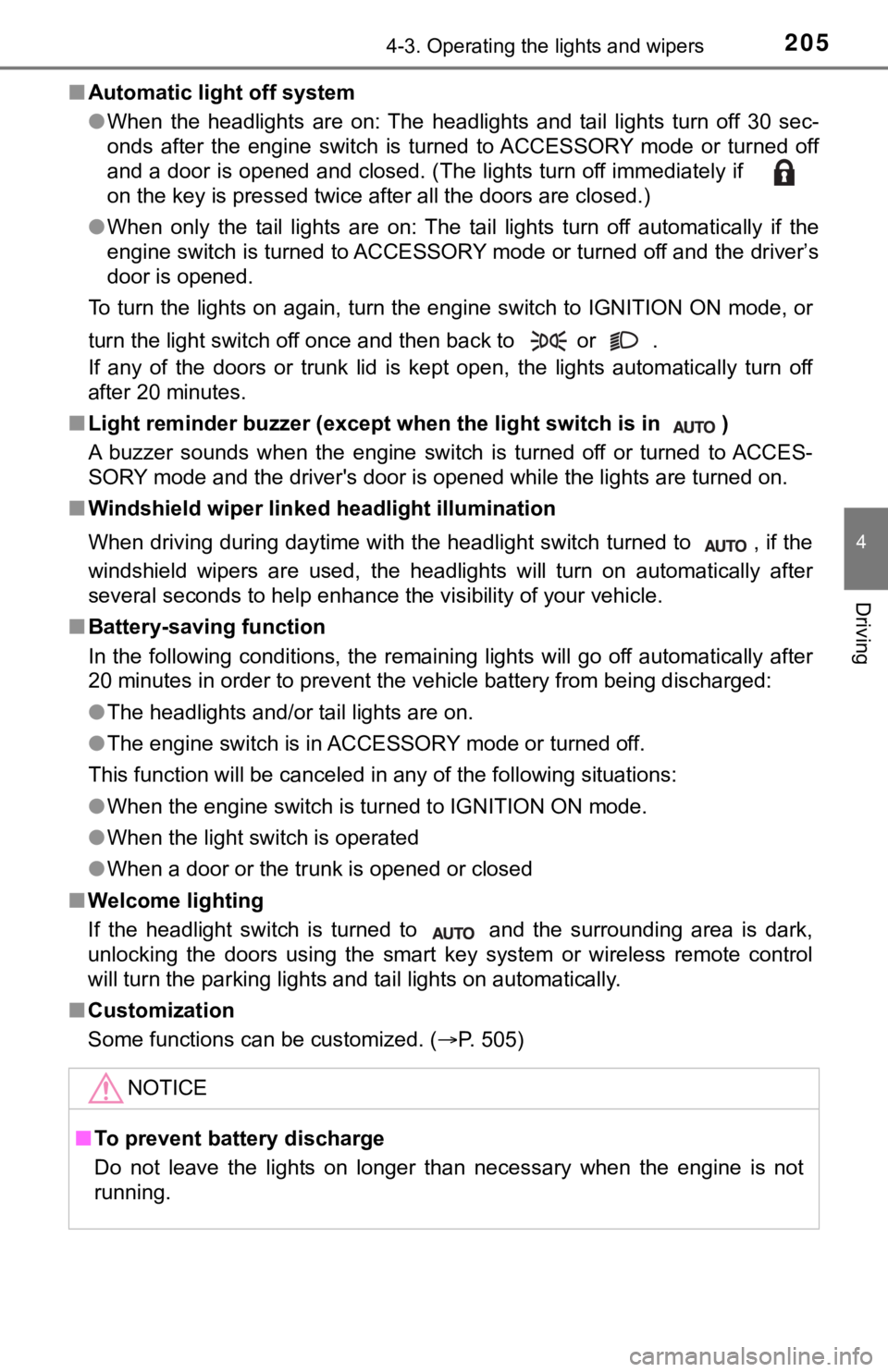
2054-3. Operating the lights and wipers
4
Driving
■Automatic light off system
●When the headlights are on: The headlights and tail lights turn off 30 sec-
onds after the engine switch is turned to ACCESSORY mode or turned off
and a door is opened and closed. (The lights turn off immediately if
on the key is pressed twice after all the doors are closed.)
●When only the tail lights are on: The tail lights turn off automatically if the
engine switch is turned to ACCESSORY mode or turned off and the driver’s
door is opened.
To turn the lights on again, turn the engine switch to IGNITION ON mode, or
turn the light switch off once and then back to or .
If any of the doors or trunk lid is kept open, the lights automatically turn off
after 20 minutes.
■Light reminder buzzer (except when the light switch is in )
A buzzer sounds when the engine switch is turned off or turned to ACCES-
SORY mode and the driver's door is opened while the lights are turned on.
■Windshield wiper linked headlight illumination
When driving during daytime with the headlight switch turned to , if the
windshield wipers are used, the headlights will turn on automatically after
<005600480059004800550044004f000300560048004600520051004700560003005700520003004b0048004f0053000300480051004b004400510046004800030057004b004800030059004c0056004c0045004c004f004c0057005c000300520049000300
5c005200580055000300590048004b004c0046004f00480011[
■Battery-saving function
In the following conditions, the remaining lights will go off automatically after
20 minutes in order to prevent the vehicle battery from being discharged:
●The headlights and/or tail lights are on.
●The engine switch is in ACCESSORY mode or turned off.
This function will be canceled in any of the following situations:
●<003a004b0048005100030057004b0048000300480051004a004c0051004800030056005a004c00570046004b0003004c005600030057005800550051004800470003005700520003002c002a0031002c0037002c0032003100030032003100030050005200
4700480011[
●When the light switch is operated
●When a door or the trunk is opened or closed
■Welcome lighting
If the headlight switch is turned to and the surrounding area is dark,
unlocking the doors using the smart key system or wireless remote control
will turn the parking lights and tail lights on automatically.
■Customization
Some functions can be customized. (P. 505)
NOTICE
■To prevent battery discharge
Do not leave the lights on longer than necessary when the engine is not
running.
Page 206 of 548
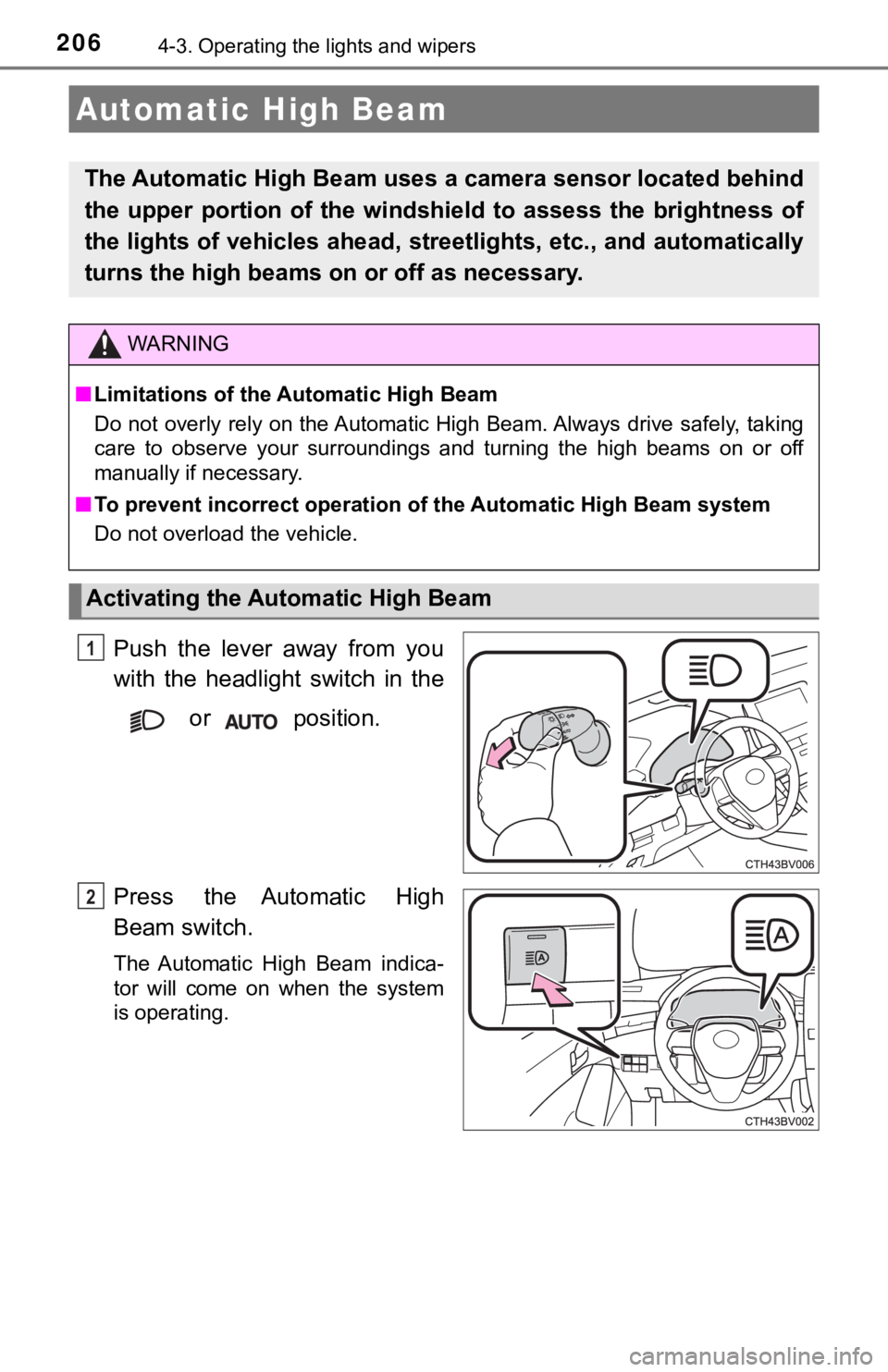
2064-3. Operating the lights and wipers
Push the lever away from you
with the headlight switch in the
or position.
Press the Automatic High
Beam switch.
The Automatic High Beam indica-
tor will come on when the system
is operating.
Automatic High Beam
The Automatic High Beam uses a camera sensor located behind
the upper portion of the windshield to assess the brightness of
the lights of vehicles ahead, streetlights, etc., and automatically
turns the high beams on or off as necessary.
WARNING
■Limitations of the Automatic High Beam
Do not overly rely on the Automatic High Beam. Always drive safely, taking
care to observe your surroundings and turning the high beams on or off
manually if necessary.
■To prevent incorrect operation of the Automatic High Beam system
Do not overload the vehicle.
Activating the Automatic High Beam
1
2
Page 207 of 548
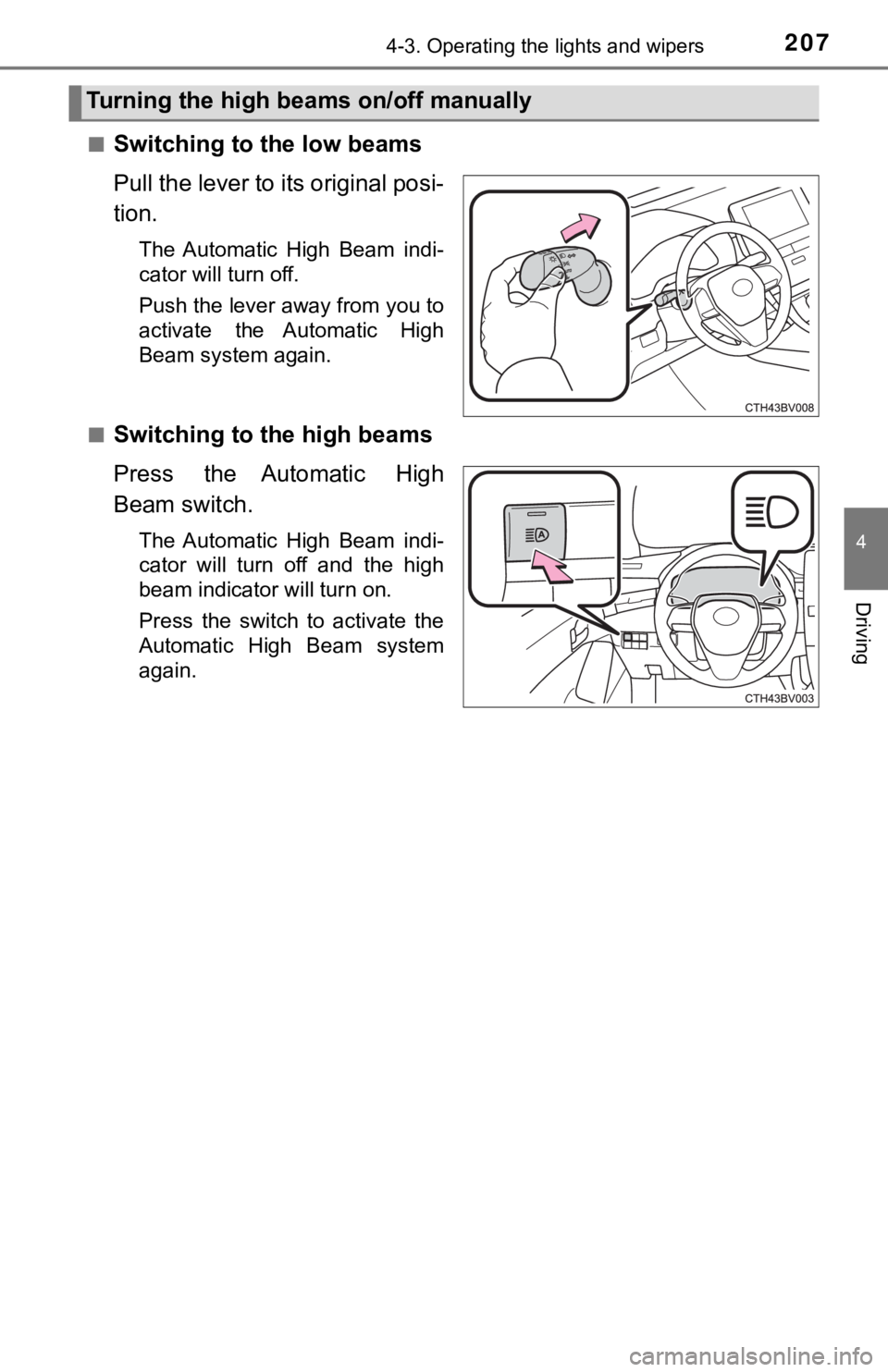
2074-3. Operating the lights and wipers
4
Driving
■Switching to the low beams
Pull the lever to its original posi-
tion.
The Automatic High Beam indi-
cator will turn off.
Push the lever away from you to
activate the Automatic High
Beam system again.
■
Switching to the high beams
Press the Automatic High
Beam switch.
The Automatic High Beam indi-
cator will turn off and the high
beam indicator will turn on.
Press the switch to activate the
Automatic High Beam system
again.
Turning the high beams on/off manually
Page 208 of 548

2084-3. Operating the lights and wipers
■Conditions to turn the high beams on/off automatically
●When all of the following conditions are met, the high beams will be turned
on automatically (after approximately 1 second):
• The vehicle speed is approximately 21 mph (34 km/h) or more.
• The area ahead of the vehicle is dark.
• There are no vehicles ahead with headlights or tail lights turned on.
• There are few streetlights on the road ahead.
●If any of the following conditions is met, the high beams will turn off automat-
ically:
• The vehicle speed is below approximately 17 mph (27 km/h).
• The area ahead of the vehicle is not dark.
• Vehicles ahead have their headlights or tail lights turned on.
• There are many streetlights on the road ahead.
■Camera sensor detection information
●The high beams may not be automatically turned off in the following situa-
tions:
• When a vehicle suddenly appears from around a curve
• When the vehicle is cut in front of by another vehicle
• When vehicles ahead cannot be detected due to repeated curves, road
dividers or roadside trees
• When vehicles ahead appear in a faraway lane on a wide road
• When the lights of vehicles ahead are not on
●The high beams may be turned off if a vehicle ahead that is using fog lights
without its headlights turned on is detected.
●House lights, street lights, traffic signals, and illuminated billboards or signs
and other reflective objects may cause the high beams to change to the low
beams, or the low beams to remain on.
●The following factors may affect the amount of time taken for the high
beams to turn on or off:
• The brightness of the headlights, fog lights, and tail lights of vehicles
ahead
• The movement and direction of vehicles ahead
• When a vehicle ahead only has operational lights on one side
• When a vehicle ahead is a two-wheeled vehicle
• The condition of the road (gradient, curve, condition of the road surface,
etc.)
• The number of passengers and amount of luggage in the vehicle
●The high beams may turn on or off unexpectedly.
●Bicycles or similar vehicles may not be detected.